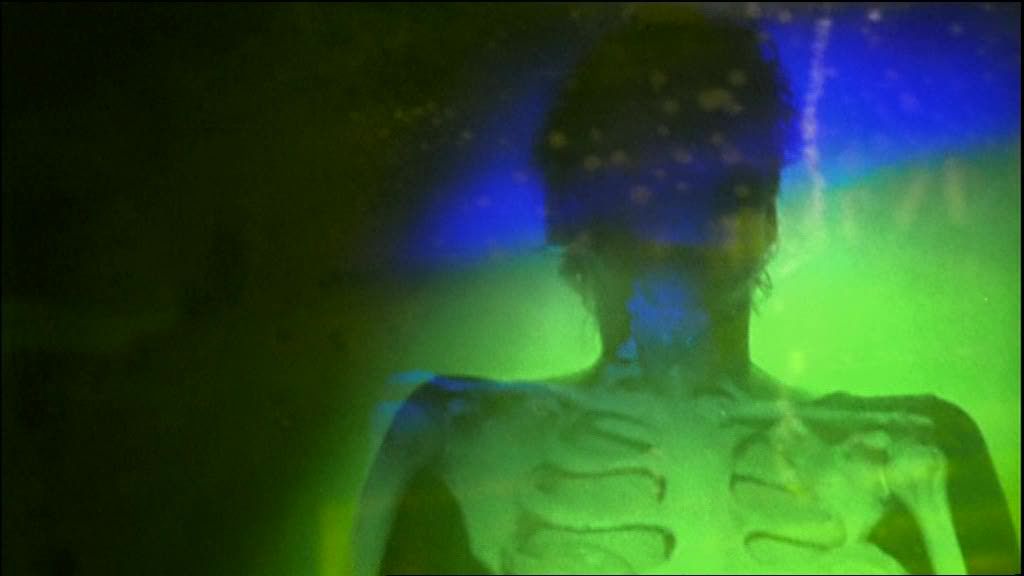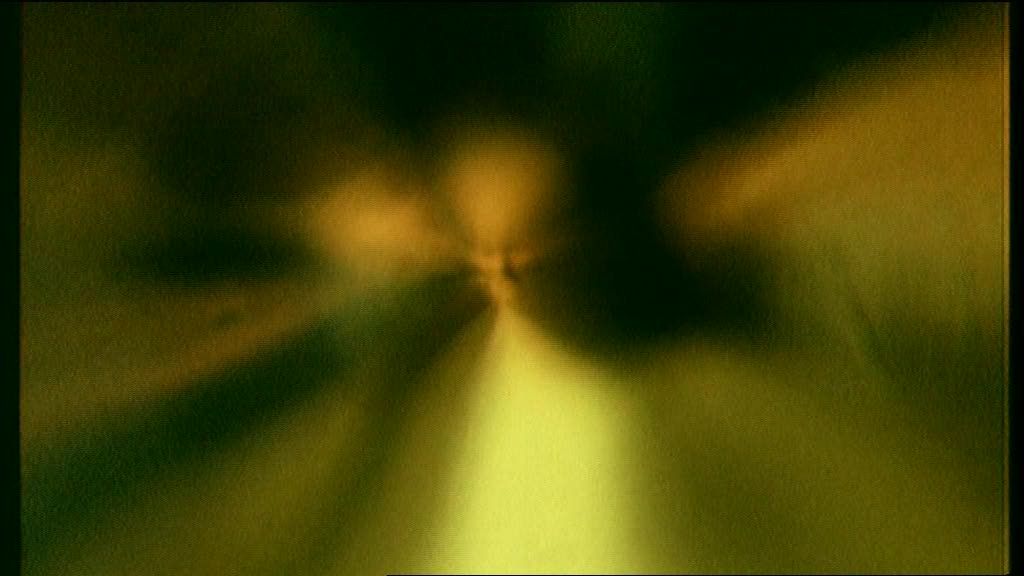
When the sight of the French painter and filmmaker Hugues de Montalembert was taken from him by a violent robbery at his home in New York, he was unwilling to give up on his life. He forced himself through a recovery period, learned how to get around and navigate as independently as possible, began to write, traveled incessantly around the world without assistance or company. His story is remarkable, moving, and has all the makings of the kind of "hope from tragedy" story that provides powerful evidence of human resilience and unfortunate fodder for dozens of saccharine movies. However, Gary Tarn's Black Sun avoids the usual traps of these kinds of films: despite his emphasis on Montalembert's narration and story, he delves beyond the surface tragedy and recovery into a deeper meditation on sensation, independence, human relationships, and the often mysterious linkages between mind and body.
From the beginning, Tarn envisions Montalembert's loss of vision in consistently inventive, striking ways. The painter's disconnection from his world, his sensory isolation, is translated into a dichotomy between sound and image. The soundtrack consists primarily of the painter's autobiographical monologue, describing the attack that blinded him, his process of recovery, and the creative paths his life has taken in the aftermath of this trauma. His voice is calm, his cadence slow and deliberate, and his carefully worded voiceover naturally tends towards the philosophical and psychological ramifications of his new condition. What does it mean for a visual artist to lose his sight? How do the other senses create different "images" of the world? What is lost by this change? What is gained? Why does the mind continue to create images, both abstract and representational, even in the absence of sight? How do other people react to those who can't see them? Montalembert's narration is often affecting in exactly the ways you'd expect — his account of the attack is harrowing, and his description of losing friends and lovers who can't bear to see him anymore is heartbreaking — but more often he seems to view his experiences as an excuse to examine himself, his mind, and his understanding of the world. His steady, unwavering voice rarely betrays a hint of emotion regarding his blindness, retaining its contemplative distance and simply describing what he thinks.

This description is necessary because the images that Tarn chooses to accompany the narration usually do not illustrate the painter's story in any literal way. There are but two scenes where the images correspond to the physical reality of the story: one in which a pair of steel wraparound "glasses" are created to shield Montalembert's eyes, and another in which he describes how he lost 12 pages of writing because he was unable to tell that his pen had run out of ink. For the latter scene, Tarn stages a recreation, showing a blank notebook with his subject's pen running across the page, scribbling unseen words that will never be read as the page remains unmarked. It is the only point in the film in which the images ostensibly show Montalembert himself, even though we only see the narrator's hand holding a pen. Throughout the rest of the film, Tarn's camera is even more oblique.
The film opens with a few minutes of shaky aerial footage of New York City as Montalembert describes his attack, the camera keeping its distance from the horrifying story being told. In other places, the camera roves through the street, capturing random faces and surprising moments of humor or sadness as it catches people in the course of their daily lives. This is a secondary level of documentary within the film, a documentary that often has little to do with its ostensible subject, instead choosing to linger on striking images from the places where Montalembert has lived or visited. It's something like a travelogue that the blinded filmmaker might've assembled had he been able to film his own journeys. Tarn also frequently resorts to abstraction, including several minutes of Brakhagian light experiments in the immediate aftermath of Montalembert's loss of sight. Images are warped and manipulated in interesting ways: funhouse-mirror distortions of street scenes, shots of faces twisting amidst a sea of television static, colorful digital overlays that inevitably bring to mind the "Zone" from Chris Marker's Sans Soleil. In one shot, a ghost-like girl, drained of color, her eyes blacked out from view, plays on a swing, her joyful smile discordant with the melancholy mood created by Tarn's distortions.

The distance between sound and image in this film dovetails nicely with a portion of Montalembert's monologue where he describes the joy of walking, as a blind man, with a painter friend, who sees everything so clearly and in such detail that his descriptions are an artform. Through his blindness, Montalembert comes to realize that sight is an act of creativity, a way of creating a world by choosing what to see, what to focus on, what to notice; it's a creative act that most people, seeing only what they need to in order to get through their days, rarely engage in. In Tarn's film, the painter's descriptions of the world become a metaphor for Montalembert's own monologue, his descriptions of his interior state. Just as the painter sees everything around him so acutely, Montalembert's thought processes have a crystalline clarity even when circling around complex abstract concepts. Tarn's gorgeous but stubbornly non-representational cinematography necessitates the monologue, ingeniously putting the blind narrator into the role of the painter who must describe, with all his creativity, what the audience cannot see for themselves.
This subtle metaphor is a constant subtext in the film, flowing through the tension between the voiceover and the allusive, elusive images chosen to illustrate these words. It is no surprise that Tarn is primarily a composer, and that Black Sun is his first effort as a filmmaker, not because the film is technically inept (far from it), but because his attentiveness to sound inscribes every moment of it. His score, quietly under-girding Montalembert's narration, combines delicate, repetitive piano figures with synthesizer and other electronic touches, creating a moody, swirling bed of sound that often emotionally enforces both the images and the narration, uniting the film's two separately realized components. The film's effect is stimulating, thought-provoking, and incredibly moving. It immerses the audience in sensation, and even more so in the contemplation of sensation and what relationships exist between the senses, the human consciousness, and the world that's created by this collaboration of the mind and the eyes.
Hi, this is Shubhajit Lahiri here. I'm a big admirer of your blog - your love for cinema as well as the exceptional (and detailed) reviews and analyses you write.
ReplyDeleteI'm a member of the core team behind Culturazzi Cognoscente Club (http://culturazzi.org/review/) - a dynamic new online non-profit startup that aims to provide a platform for discussions, reviews and articles for anything that the contributors feel qualify as "Arts" - books, music, cinema, theatre, painting, graphic novels, photography et al.
I would like to invite you to have a look at the site, and if it interests you, to join the team and contribute for it. It would be a pleasure to have you on board.
You may contact Ankur Sharma (culturazzi@hotmail.com) or me (shubhajit4u@gmail.com) if you have any queries.
Awaiting your response.
Ed - The first thing that came to mind as I started to read your wonderful analysis was Oliver Sack's book An Anthropologist on Mars, which starts with the case of an artist who can no longer see color. It also brought to mind the works of Antonio DaMasio, a neurologist who studies the origins and nature of consciousness.
ReplyDeleteAs I am a huge fan of the abovementioned, I am intrigued by your description of this film. Is this available on DVD?
Hey Marilyn, thanks for mentioning Sacks, that book looks very interesting. I'm always interested in the intersections between hard science and more poetic/literary/creative realms.
ReplyDeleteBlack Sun is available on an excellent DVD from Second Run in the UK. So as long as you can play Region 2 DVDs, it's well worth taking a look. I seriously can't say enough good things about this movie.
Great! I have an all-region DVD player. I'll put it on my wish list along with the Dennis Potter box set.
ReplyDeleteunfortunately the edition only has the English dubbed version and not the original French version, much more emotional, in my opinion.
ReplyDelete